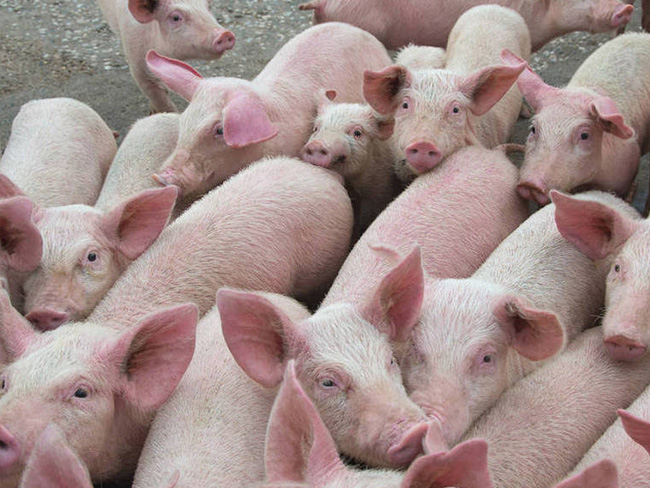How to improve pig performance in hot summer
- Categories: Feeding management
- Author:
- Origin:
- Time of issue:2019-02-26
- Views: 49
(Summary description) Ensure adequate drinking water. In the case of high temperature, pigs mainly rely on evaporation to dissipate heat to ensure sufficient and cool drinking water, which is one of the effective measures to prevent heatstroke. The water pipes exposed to sunlight are deeply buried, and the depth is preferably more than 20 cm. Make sure the drinking water delivered to the barn is cool.
How to improve pig performance in hot summer
(Summary description) Ensure adequate drinking water. In the case of high temperature, pigs mainly rely on evaporation to dissipate heat to ensure sufficient and cool drinking water, which is one of the effective measures to prevent heatstroke. The water pipes exposed to sunlight are deeply buried, and the depth is preferably more than 20 cm. Make sure the drinking water delivered to the barn is cool.
- Categories: Feeding management
- Author:
- Origin:
- Time of issue:2019-02-26
- Views: 49
Core tip: hot summer has a great impact on the production performance of pig herds. At present, it is an effective method to take comprehensive preventive measures. Based on years of practical experience, the author discusses the measures to improve the production performance of pig herds in summer as follows, hoping to improve the production performance of pigs. helpful.
Create the best possible environment for the herd
Improve the external environment of the pig house
1. Do a good job in the greening of the pig farm. By planting tall trees, such as fast-growing eucalyptus, poplar, etc., on both sides of the pig farm road and between the pig houses, the heat radiation in summer can be reduced by 60%-80%, and the ambient temperature of the pig house can be reduced by 3°C-4°C. At the same time, grass is planted in the field to reduce the proportion of cement floor to adjust and improve the microclimate environment of the field.
2. Roof reinforced thermal insulation design. The roof adopts thermal insulation materials, such as foam, wood, etc., which can reduce the transmission of radiant heat to the house. Foam is cheaper and works better.
3. Regularly disinfect pig houses and facilities. The pig house should be kept in good hygienic condition, including the disinfection of pens, fields, utensils, equipment, drainage channels, air, etc., and should also pay attention to some hygienic dead corners, such as pig loading table, sewage ditch, water storage tank, food trough, etc. Disinfection of premises and facilities.
Improve the internal environment of the pig house
1. Reduce stocking density. Excessive pig herds and high stocking density can aggravate heat stress. Therefore, the stocking density should be appropriately reduced according to the actual situation.
2. Lower the ambient temperature
Drop or mist to cool down. Dripping water cooling must be combined with ventilation to cool down through the evaporation of water, but the humidity should not be too large, otherwise it will easily cause diarrhea in suckling piglets. This method is suitable for single-positioned lactating and pregnant sows. Atomization and cooling should not be started for a long time, and a pulse switch can be used (ie, open for 10 minutes and stop for 10 minutes). It is suitable for boar houses, gestation houses, fattening houses and piglets.
Cool down machinery. The equipment has an air conditioning system and a cooling pad-fan cooling system, which is suitable for single-positioned lactating sows or artificially inseminated boars.
Adjust feed formula nutritionally to ensure proper nutritional level
1. Ensure adequate drinking water. In the case of high temperature, pigs mainly rely on evaporation to dissipate heat to ensure sufficient and cool drinking water, which is one of the effective measures to prevent heatstroke. The water pipes exposed to sunlight are deeply buried, and the depth is preferably more than 20 cm. Make sure the drinking water delivered to the barn is cool.
2. Adjust the feed formula in time.
①The sow's pre-feed formula can be adjusted appropriately: corn is reduced by 20 catties, and bran is increased by 20 catties. The feed formula for lactation can also be adjusted appropriately: soybean meal is reduced by 30 catties, corn is reduced by 10 catties, fish meal is increased by 20 catties, and bran is increased by 20 catties. Conditional pig farms can also feed some green and juicy feed, which can enhance the sow's ability to resist heat stress.
②Adding 2%-3% oil to the feed to increase the crude protein content in the feed can improve the heat stress resistance of breeding pigs. In summer, oil is easy to mildew, and it is only suitable for temporary addition during feeding.
③A new type of mycotoxin treatment agent, such as dark blue Meijiaqi, should be added to the feed to prevent the mycotoxins in the feed from harming the health of the pig herd. The breeder should clean up the residual feed in the sow's trough before going off work every day to prevent the sow from eating rancid and spoiled feed.
Scan the QR code to read on your phone
Causes of sudden death in broilers
天元药业
Tianyuan Pharmaceutical
Add: No. 34, Changsheng Street, Luquan District, Shijiazhuang City, Hebei Province Tel:0086-311-83980006/83980378 Fax:0086-311-83980378 E-mail:ty@tianyuanyaoye.com.cn






